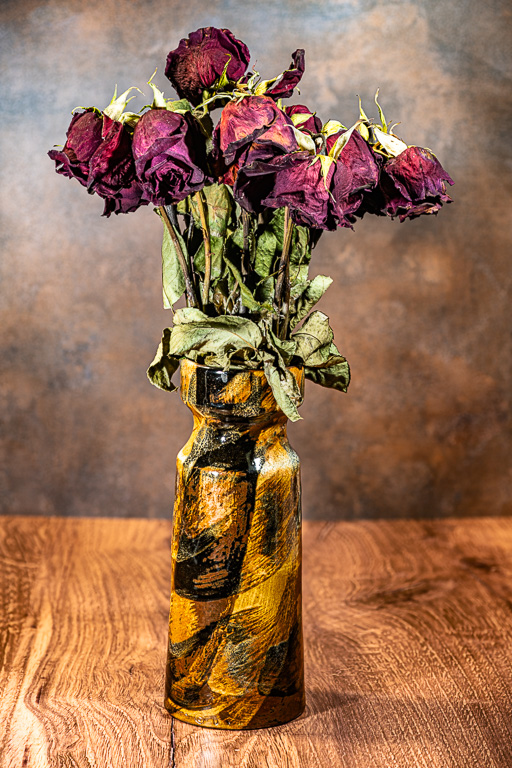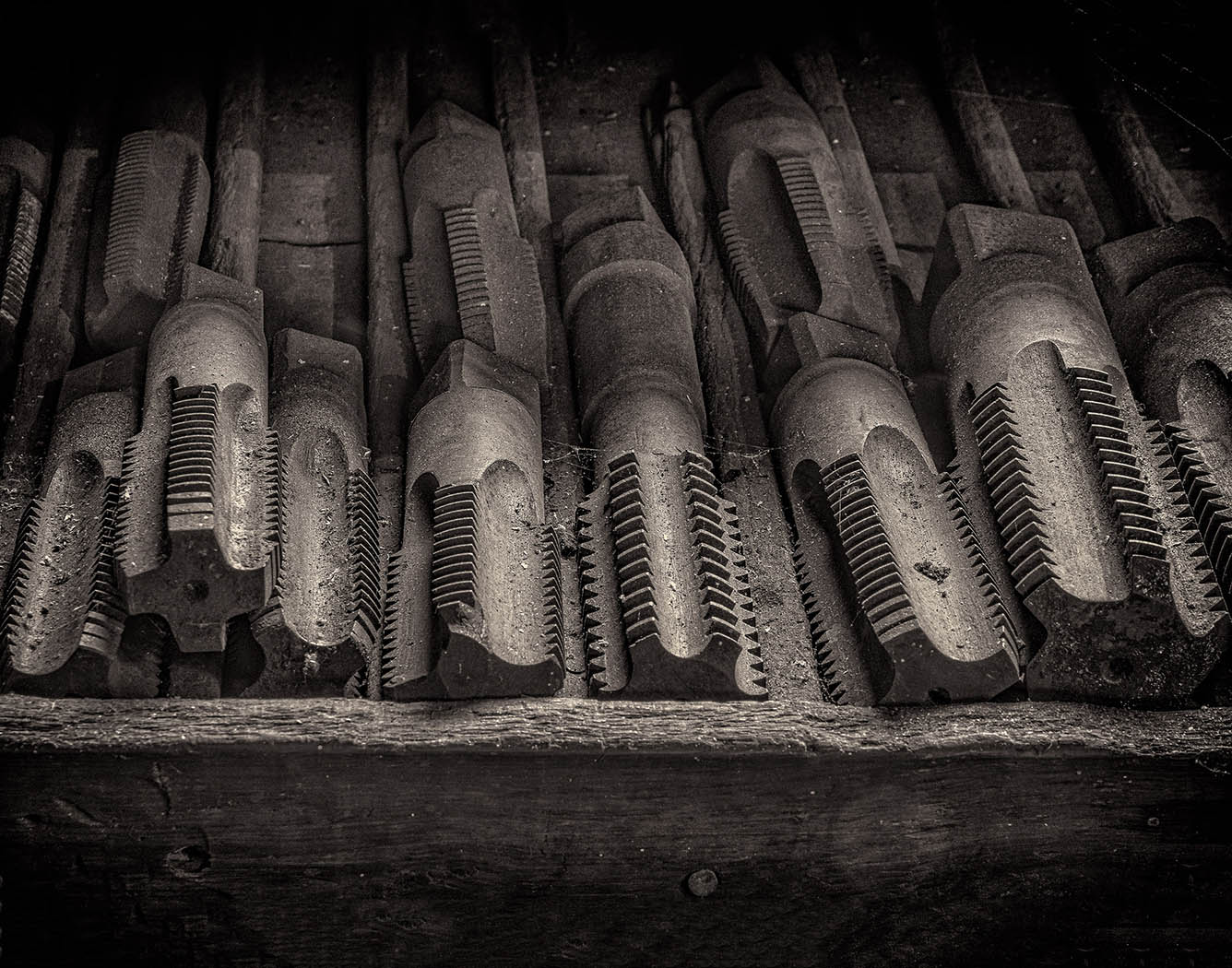Alan Kiecker, QPSA
About the Image(s)
Description: I have been experimenting with still lifes. I recently acquired some backdrops from ReplicaSurfaces.com. I had saved some roses from Valentines Day to create this still life with the backdrops and the roses well past their prime.
Technical: Focus stacked image from 7 images each 0.4 sec, f/5.6, ISO 64 with 24-120mm lens @ 70mm.
This round’s discussion is now closed!
5 comments posted
I can't say that this subject conforms to my usual definition of wabi-sabe. The concept embraces the beauties of long use, accentuating the permanence of the object. The classic example is an old scholar's ink stone. Here you emphasize impermanence. I am attaching an image from my "Ghost Factories" exhibit that conveys the concept.
Judging the image, I see the definitive tilt to the right, and I'm not sure if having a wooden table and a wooden vase is too many wood tones. I would suggest straightening the image, and setting the vase on on gray or black tile to simplify the image. Conversely, you might have tried to use a glass vase, which would reveal the stems and add some visual interest by refraction. Posted: 03/15/2025 09:08:25
Judging the image, I see the definitive tilt to the right, and I'm not sure if having a wooden table and a wooden vase is too many wood tones. I would suggest straightening the image, and setting the vase on on gray or black tile to simplify the image. Conversely, you might have tried to use a glass vase, which would reveal the stems and add some visual interest by refraction. Posted: 03/15/2025 09:08:25
According to Wikipedia, 'In traditional Japanese aesthetics, wabi-sabi is centered on the acceptance of transience and imperfection. The aesthetic is sometimes described as one of appreciating beauty that is "imperfect, impermanent, and incomplete" in nature. It is prevalent in many forms of Japanese art.'
A few years back, Lisa Cuchera (OM System Ambassador) gave a presentation to my camera club on wabi-sabi as there being "beauty in the imperfect". She goes to her local flower shop to obtain flowers that are well past their prime and they are no longer able to sell. This has now become a regularly used topic in my camera club's monthly salons. The flowers here are roses that I had given my wife for Valentine's Day. Before throwing them to the mulch pile I took a few photos.
This was my first attempt at trying something new. I agree that there is probably too much brown. I will try something more contrasty next time.
Posted: 03/15/2025 10:42:20
A few years back, Lisa Cuchera (OM System Ambassador) gave a presentation to my camera club on wabi-sabi as there being "beauty in the imperfect". She goes to her local flower shop to obtain flowers that are well past their prime and they are no longer able to sell. This has now become a regularly used topic in my camera club's monthly salons. The flowers here are roses that I had given my wife for Valentine's Day. Before throwing them to the mulch pile I took a few photos.
This was my first attempt at trying something new. I agree that there is probably too much brown. I will try something more contrasty next time.
Posted: 03/15/2025 10:42:20
Coincidentally, Lisa will doing a presentation to my camera club this Thursday. I look forward to attending and hearing her thoughts, In the meantime, we can conclude this consideration in the same way the Wiki article ends:
"In 2009, Marcel Theroux presented "In Search of Wabi Sabi" on BBC Four, as part of the channel's Hidden Japan season of programming, travelling throughout Japan trying to understand the aesthetic tastes of its people. Theroux began by comically enacting a challenge from the book Living Wabi Sabi by Taro Gold, asking members of the public on a street in Tokyo to describe wabi-sabi - the results of which showed that, just as Gold predicted, "they will likely give you a polite shrug and explain that Wabi Sabi is simply unexplainable."" Posted: 03/15/2025 20:00:12
"In 2009, Marcel Theroux presented "In Search of Wabi Sabi" on BBC Four, as part of the channel's Hidden Japan season of programming, travelling throughout Japan trying to understand the aesthetic tastes of its people. Theroux began by comically enacting a challenge from the book Living Wabi Sabi by Taro Gold, asking members of the public on a street in Tokyo to describe wabi-sabi - the results of which showed that, just as Gold predicted, "they will likely give you a polite shrug and explain that Wabi Sabi is simply unexplainable."" Posted: 03/15/2025 20:00:12
Lisa was very inspirational for our club. I am sure that you will enjoy her.
Her topic may be something other than what she gave us. If you have the opportunity, ask her about wabi-sabi. And drop me a note about her presentation. We are always looking for programs. Perhaps we should have her again. Posted: 03/15/2025 21:22:19
Her topic may be something other than what she gave us. If you have the opportunity, ask her about wabi-sabi. And drop me a note about her presentation. We are always looking for programs. Perhaps we should have her again. Posted: 03/15/2025 21:22:19
Hi Alan
I didn't notice the tilt to the right w/out Craig pointing it out… it's pretty subtle to my eye. I do agree about the various earthy tones and patterns though, that vase is almost as prominent as the roses themselves. That said, your snazzy new backdrop works well with the flowers themselves.
Compositionally, you might play with leaving a little more room to breathe at the top, above the roses.
Thanks for sharing
Josh Posted: 03/19/2025 02:09:44
I didn't notice the tilt to the right w/out Craig pointing it out… it's pretty subtle to my eye. I do agree about the various earthy tones and patterns though, that vase is almost as prominent as the roses themselves. That said, your snazzy new backdrop works well with the flowers themselves.
Compositionally, you might play with leaving a little more room to breathe at the top, above the roses.
Thanks for sharing
Josh Posted: 03/19/2025 02:09:44

